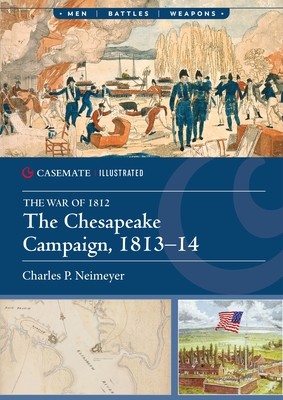
- We will send in 10–14 business days.
- Author: Charles P Neimeyer
- Publisher: Casemate
- ISBN-10: 1636245404
- ISBN-13: 9781636245409
- Format: 16.6 x 23.6 x 0.8 cm, minkšti viršeliai
- Language: English
- SAVE -10% with code: EXTRA
Reviews
Description
In early 1813, Britain launched a campaign on the Chesapeake Bay to try and divert American regulars from the Canadian border and put pressure on the United States to come to terms. Wishing to keep the Regular Army on the northern front, Secretary of War John Armstrong chose to rely on local forces and state militias to protect the Chesapeake Bay region, believing British raids posed more of a distraction than a serious threat. This defensive approach meant that towns, ports, and even the nation's capital were left vulnerable to attack, and the responsibility for protection largely fell to less experienced, hastily organized militia units.
While American forces successfully defended Craney Island near Norfolk, staving off British occupation, British forces routed an American force at Bladenburg, opening the path to Washington, where they set fire to public buildings, including the White House and the Capitol. This symbolic victory was followed by the Battle of North Point and the defense of Fort McHenry, where Americans managed to turn back British forces in Baltimore. Although the British raid on Washington was a symbolic coup, it did not disrupt the U.S. government or significantly affect the war. The failed attempt to capture Baltimore, combined with a decisive American victory at Plattsburgh, New York, underscored American resilience and contributed to Britain's decision to end the war without any territorial concessions.
Illustrated with photographs and maps, The U.S. Army in the Chesapeake Campaign 1813-14 examines this campaign's key engagements.
- Author: Charles P Neimeyer
- Publisher: Casemate
- ISBN-10: 1636245404
- ISBN-13: 9781636245409
- Format: 16.6 x 23.6 x 0.8 cm, minkšti viršeliai
- Language: English English
In early 1813, Britain launched a campaign on the Chesapeake Bay to try and divert American regulars from the Canadian border and put pressure on the United States to come to terms. Wishing to keep the Regular Army on the northern front, Secretary of War John Armstrong chose to rely on local forces and state militias to protect the Chesapeake Bay region, believing British raids posed more of a distraction than a serious threat. This defensive approach meant that towns, ports, and even the nation's capital were left vulnerable to attack, and the responsibility for protection largely fell to less experienced, hastily organized militia units.
While American forces successfully defended Craney Island near Norfolk, staving off British occupation, British forces routed an American force at Bladenburg, opening the path to Washington, where they set fire to public buildings, including the White House and the Capitol. This symbolic victory was followed by the Battle of North Point and the defense of Fort McHenry, where Americans managed to turn back British forces in Baltimore. Although the British raid on Washington was a symbolic coup, it did not disrupt the U.S. government or significantly affect the war. The failed attempt to capture Baltimore, combined with a decisive American victory at Plattsburgh, New York, underscored American resilience and contributed to Britain's decision to end the war without any territorial concessions.
Illustrated with photographs and maps, The U.S. Army in the Chesapeake Campaign 1813-14 examines this campaign's key engagements.


Reviews